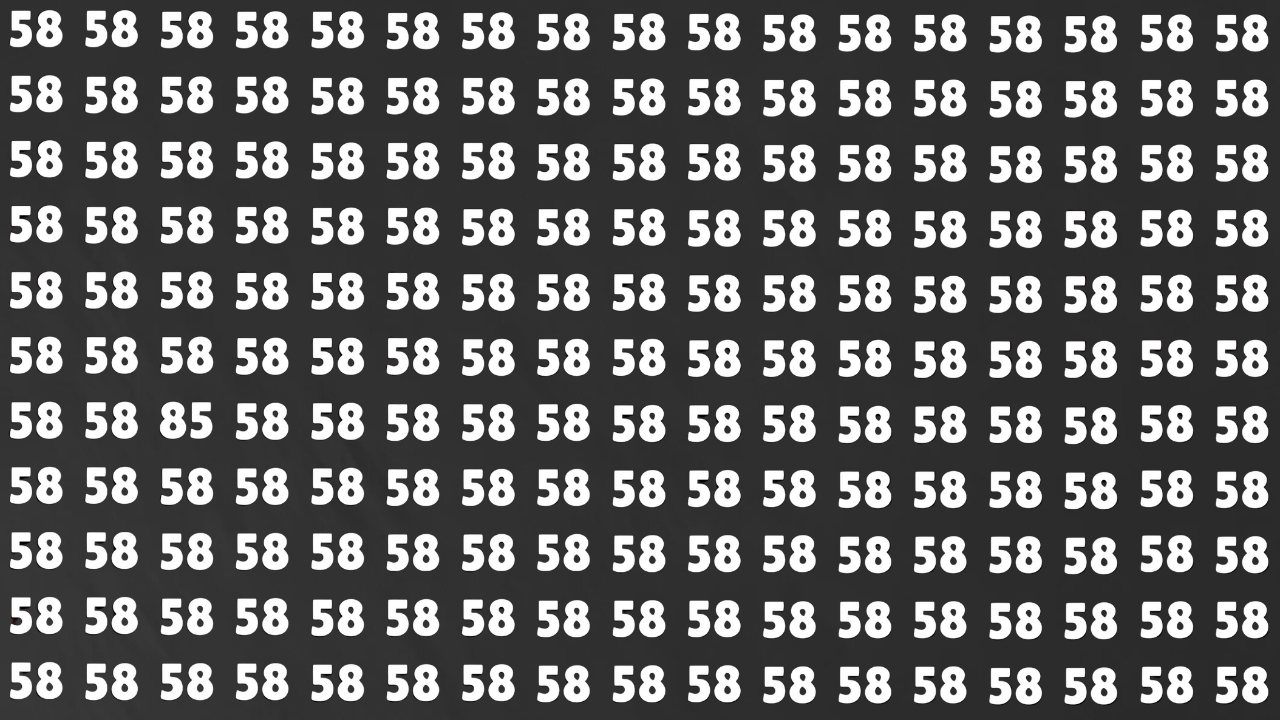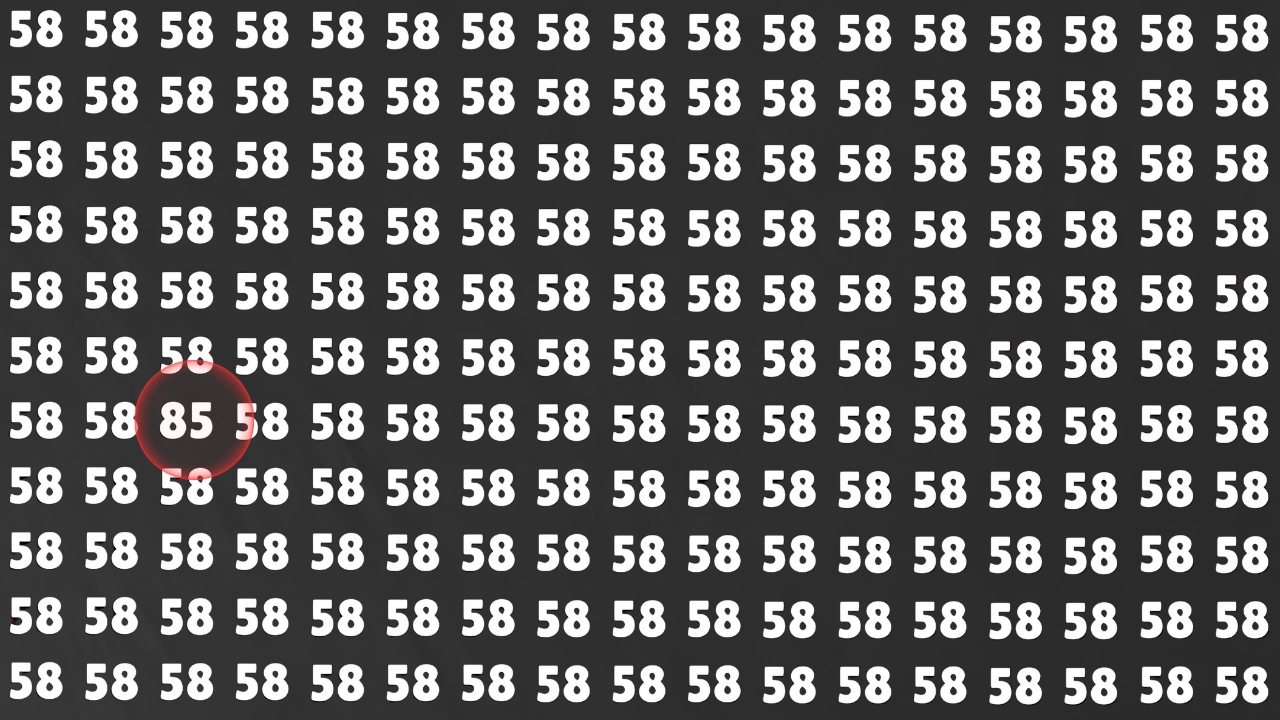Hidden Number 85 : Have you ever stared at what seems like a simple grid of numbers, only to feel completely stumped by what should be an easy task? Welcome to the captivating world of optical illusions, where finding the number 85 hidden among dozens of 58s can leave even the sharpest minds scratching their heads.
What Makes These Puzzles So Tricky?
When you first glance at a field of similar-looking numbers, your brain takes shortcuts. It’s actually trying to help you by recognizing patterns quickly, but sometimes this efficiency works against you. The numbers 58 and 85 are particularly sneaky because they contain the exact same digits – just flipped around. Your mind sees the familiar shapes of 5 and 8 and assumes it knows what it’s looking at.
Think about it: when you’re scanning quickly, your brain focuses on the overall shape rather than the specific order of digits. Both numbers have that curved 8 and the angular 5, creating a visual similarity that can fool even careful observers.
Why 6 Seconds Matters

The six-second time limit isn’t arbitrary – it’s based on how our visual processing actually works. In those first few seconds, your eyes are doing rapid movements called saccades, jumping from one area to another. Your brain is simultaneously trying to process all this information while filtering out what it thinks is “noise” (in this case, all those 58s).
Some people can spot the hidden 85 almost instantly, while others might stare for minutes without success. This difference often comes down to individual variations in visual processing, attention patterns, and even the specific strategy your brain naturally uses when scanning information.
The Science Behind Your Struggle
Your visual system is incredibly sophisticated, but it has built-in biases. When you see multiple instances of the same number, your brain creates what researchers call a “search template” – essentially, it decides what to look for and what to ignore. Unfortunately, when the target (85) is so visually similar to the distractors (58), this template can work against you.
There’s also something called “change blindness” at play. Even if your eyes actually pass over the correct number, your brain might not register it as different because it’s not expecting that particular arrangement of familiar digits.
Strategies That Actually Work
Instead of randomly scanning, try these approaches that work with your brain’s natural tendencies:
Start from one corner and work systematically. Pick the top-left and move row by row, or column by column. This prevents your eyes from jumping around chaotically and ensures you don’t accidentally skip areas.
Focus on the first digit. Since you’re looking for 85 among 58s, train your eyes to spot numbers that start with 8 rather than 5. This gives your brain a clearer search target.
Use peripheral vision to your advantage. Sometimes, relaxing your direct focus and using your peripheral vision can help you notice patterns that stand out from the crowd.
Take micro-breaks. If you’re struggling after a few seconds, look away briefly and then return. This resets your visual processing and can help you see things you missed before.
More Than Just Entertainment
These optical illusion challenges aren’t just fun distractions – they’re actually great mental exercise. Regular practice with visual puzzles can improve your attention to detail, enhance your pattern recognition skills, and even boost your overall cognitive flexibility.
Healthcare professionals sometimes use similar exercises to assess visual processing abilities and attention spans. They’re also valuable tools for understanding how different people’s brains process visual information.
When Numbers Play Hide and Seek
The beauty of number-hunting puzzles lies in their simplicity. There’s no complex knowledge required, no special skills needed – just your eyes, your brain, and a bit of patience. Yet they can humble anyone, regardless of education or experience.
Some people find these challenges meditative, using them as a brief mental break from more stressful activities. Others enjoy the competitive aspect, timing themselves or challenging friends and family members.
Building Your Visual Skills
If you enjoy these puzzles, you’re in good company. They’re part of a larger family of visual challenges that includes finding hidden objects in busy scenes, spotting differences between similar images, and identifying camouflaged animals in nature photos.
Regular practice with various types of visual puzzles can actually improve your real-world observation skills. You might find yourself noticing details in your environment that you previously overlooked, or becoming better at quickly scanning for specific items when you need them.
Optical Illusion Answer

There’s something uniquely satisfying about that “aha!” moment when the hidden number finally jumps out at you. It’s often accompanied by a feeling of “how did I miss that?” – the target suddenly seems so obvious that you wonder how you struggled with it in the first place.
This experience highlights how much of perception is about attention and expectation. Once you know where the 85 is hiding, you’ll probably be able to find it quickly in future attempts because your brain now has the right search pattern.
Whether you spot the hidden 85 in seconds or need a bit more time, remember that these challenges are meant to be enjoyable. They’re a playful reminder of how fascinating and sometimes quirky our visual processing can be.